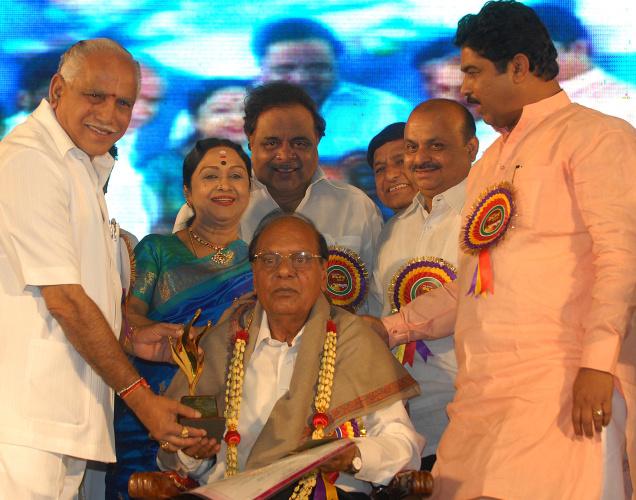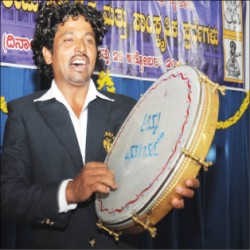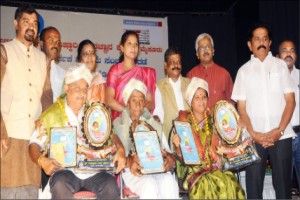
by M.L. Krishnaswami
Naaham Vasami Vaikunte
Na Yogi Hridaye Ravou
Yatra Madbhaktaha Gayanthi
Tatra Thistami Narada
Thus spake Lord Krishna to Narada, the divine messenger who could walk/fly through all the three worlds, with his Tambura in hand. Narada was also acting as a common ambassador for all the three worlds of yore, the Earth, Devaloka, where the gods were supposed to live and the Pathala Loka, below the oceans, where mostly the demons lived. He had an open Visa (strange) to visit any part of the above three worlds and was welcome in all of them. This is aside our topic for the present. The meaning or translation of the above Sanskrit Sloka is:
“I (Krishna) do not live in the heaven
Nor do I dwell in the heart of
the yogi or sage
But I dwell or live there
and there alone
Where my devotees sing
and dance in my praise”
This preface becomes relevant for this article because of the preponderance of music in the social, philosophical and cultural aspects of our land. Music, in all its form — classical (both Karnatak and Hindustani), devotional (Dasa Sahitya and Vachana Gayana) and numerous other disciplines has become a part and parcel of our rich culture and in this cradle, many organisations and Sabhas have come up in Mysore in the last century and some of them have made tremendous progress in the royal city of Mysore.
Down the memory lane, five to six-and-a-half-decades ago, Mysore was a small town with barely less than a lakh of people and the royalty was ruling the Town and the State. Fortunately those who ruled Mysore State were very benevolent people and history has put them on a pedestal enumerating all the good deeds they have done during their rule. The Palace, that marvel of great architectural splendour, was the cynosure of all cultural and related activities and the Maharajas — more significantly — Nalwadi Krishnaraja Wadiyar and Jayachamaraja Wadiyar gave tremendous support to their citizens to perpetuate the art forms of their choice. This patronage helped people to start music and dance halls etc., in the city.
In the above context was established nearly a century ago, Sri Bidaram Krishnappa Sri Rama Mandira in Shivarampet area of Mysore. A compact hall with a squatting capacity of 500-600 rasikas or music connoisseurs with an additional seating capacity of 20-30 on the side verandahs, is what makes this beautiful auditorium with Lord Rama’s benevolent eyes falling on the performing artistes, exactly opposite, and the rasikas scattered in between on floor carpets.
The hall is divided into five enclosures or portions and the side walls decorated at top with wonderful photo-images of the Dasavatharas, five on each side in order. The photos are beautifully framed with Mahagony wood and lit at the top. Lower down, the walls display photos of eminent music composers and musicians of yore. Behind the stage where the artistes sit and perform is a photograph of the founder Sri Bidaram Krishnappa. It is a magnificent hall and such marvel and beauty are absent in any hall in the whole of South India.
Come Ramanavami, it is a major feast for the Hindus and all over the land music Sabhas celebrate this as a festival of music — some times for a week and sometimes for a fortnight. Bidaram Mandira has continued to celebrate this festival for a fortnight in a grand manner inviting leading musicians of the land to perform. Long back they also used to have a dance programme included in the itinerary.
It was in March-April 1944 that I was exposed first to a music concert in the above hall. A young lad of eleven summers, I was gifted a season ticket for the Ramanavami festival by my eldest brother who was a Life Member of that Sabha. Stalwarts performed during the festival and included Ariyakudi, Semmamgudi, Chembai, G.N.B. and Madurai Mani to name a few vocalists who were accompanied by leading violinists and percussionists of the day like T. Chowdaiah, Papa Venkataramaiah, Kumbakonam Raja Manikyam Pillai (all violin) and Madurai Mani Iyer, Palani Subramanya Pillai (a left handed percussionists of repute), Mugaiah (on mridangam). Solo violin concert by the legendary Dwaram Venkata Swamy Naidu was a highlighted programme. The concerts would start at 6 pm and go upto 10 pm and Madurai Mani would even go upto 11 pm and the connoisseurs would sit through till that late hour, when he would regale them with his drum like music. The lone lady Musician I heard then was D.K. Pattammal and later in the late 40s she was joined by M.L. Vasanthakumari, also giving a separate programme.
Artistes used to be brought from Madras to Bangalore on train and then to Mysore by Car. This would normally entail some delay in transit and there would be commotion among the audience some of whom would demand for a refund of their ticket value, by which time the main artiste would come and start singing. The opening programme would invariably be from Ariyakudi — who was called the Gayaka Samrat — accompanied by T. Chowdaiah and Mani Iyer. Ariyakudi and Chowdaiah used to wear diamond ear rings and would have a gold necklace hanging down the neck. In that beautiful illuminated hall, it was a pleasure to see the sparkling diamonds on the artistes.
The concerts were without the menace of loudspeakers and the whole hall would reverberate with the original voice of the artistes. The voices of female artistes like Pattammal and Vasantha Kumari would take a little time to reach the last row of people in the hall after a few seconds and the rasikas would know that the concert has started because of the sound of violin and the mridangam.
Apart from the above Bidaram, music concerts were arranged during Hanumanthotsava by Sri Devendrappa, down the same road in Srirampet and this was also a veritable dais for many local artistes of repute. Besides this in old Agrahara also there used to be concerts on Chavadi Street arranged by Sri Venkatesh Iyengar, father of legendary Veena Doreswamy Iyengar.
Thyagaraja Jayanthi used to be organised in all the Sabhas of Mysore and this programme is being continued even today. Another feature of the programmes of yore was the presence of many of the local musicians on all the days of the festival, which unfortunately is not seen today. In this connection I had the good fortune of seeing Sri K. Vasudevacharya and Rallapall Ananthakrishna Sharma in one of the programmes arranged in Sahakara Bhavana on Chamaraja Double Road by Saraswathi Sangeetha Samaja — an off shoot of Bidaram Krishnappa Ramamandira.
In addition to the above, an organisation by name “Sangeetha Kalabhivardhini Sabha” came into being under the leadership of Sri K. Vasudevacharya and Sri H. Yoganarasimham. This Sabha used to have concerts in the premises of the Sanskrit Patashala, opposite Palace Offices and went on for quite a few years before folding up.
Golden days they were really !
source: http://www.starofmysore.com / Star of Mysore / Home> Feature Articles / Sunday, November 02nd, 2014









